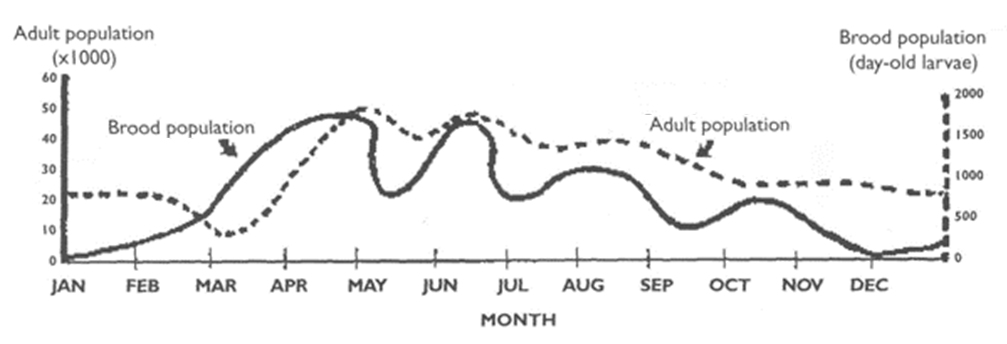The population of a bee hive fluctuates during the year according to the seasons and food resources. The queen usually lives for a couple of years (in temperate areas at least) and is replaced only during favorable resource [forage] conditions. The numbers of workers fluctuate considerably during the season. Drones are produced when resources improve in the spring and then eliminated in the fall — a seasonal pattern determined by resource availability.
In January and February, the worker adult population decreases, reaching a seasonal low sometime in February/March when a colony may have less than 20,000 bees. Increasing day length and pollen availability soon insures that birth rate exceeds death rate and the colony population grows rapidly in April, May and June. An average peak population of 60,000 bees is achieved sometime in June. Weaker colonies either have a lower peak population or reach their largest size later in the season.
The adult population remains high but drops during July and August. However, variation exists among bee races; for instance, Italian bee colonies grow slower and stay larger longer into the season than some of the other races. The time of the nectar flow has a great influence on populations during the summer. Some colonies show an increase in adult bees in the early fall before the numbers begin to decline with the fall season. The blooming periods of major nectar and pollen sources greatly influence this cycle.
The brood cycle is also seasonal. In January, many colonies rear little worker brood, and no drones or queens are raised at this time. With increasing day length and especially with the availability of early pollen, the rearing of brood increases rapidly. A queen may produce 1500 eggs daily (nearly her own body weight).
Depending upon the race, brood production continues at a high level during the summer months, although at a rate below spring levels. The number of brood cells in use can peak at 40,000. There may be a second peak in brood rearing in early fall when new pollen sources are available but then rearing of brood falls rapidly with fewer food resources, to reach zero or nearly so by December.

Drones and queens are only reared seasonally. Drone production begins in the spring as food resources become reliable and continues through the summer but not into the fall. The size of the drone adult population varies with the amount of drone brood reared. Most colonies eliminate all their drones each fall as food resources dwindle so adult drones may decrease in numbers very rapidly in September/ October. Adults do not reappear until next spring. Colonies that are without a queen tend to retain drones for a longer period in the fall.
Rearing of queens to replace existing queens is also seasonal. During favorable weather, with sufficient food resources available, a colony may attempt to divide the nest population by swarming or replace a queen by supersedure. Generally, swarming is more common during population build-up in the spring from mid-April to mid-June and occurs more frequently in temperate areas than tropical areas (except in the case of Africanized bees). During the summer, supersedure is more common than swarming. Except under very unusual circumstances, a bee colony does not rear queens during the fall, winter or early spring months.
Back to Basic Bee Biology for Beekeepers table of contents
Source:
The above text is taken from The Mid-Atlantic Apiculture Research & Extension Consortium, Basic Bee Biology for Beekeepers; Fact Sheet,MAAREC Publication 1.4 March 2004.You can download this factsheet and others at the MAAREC website
